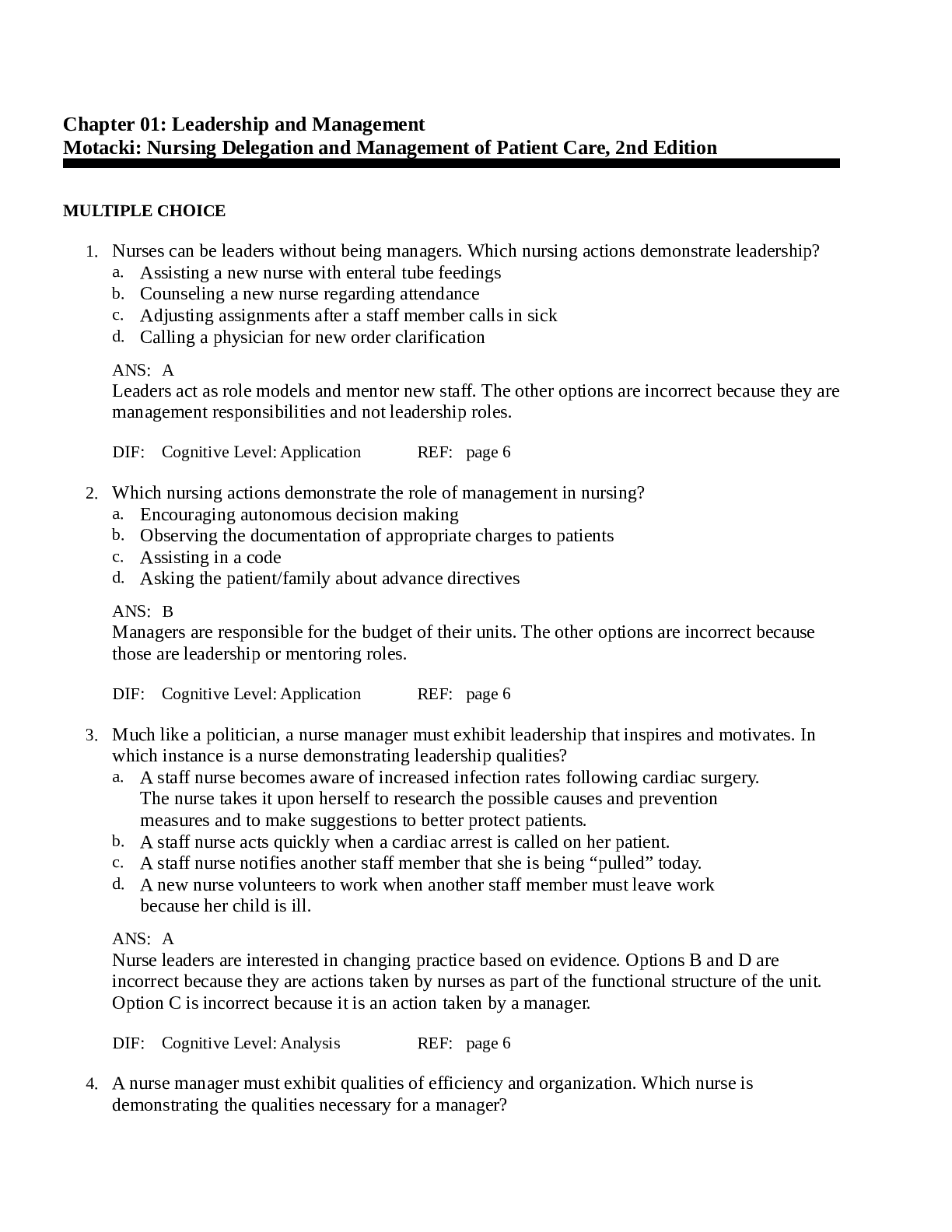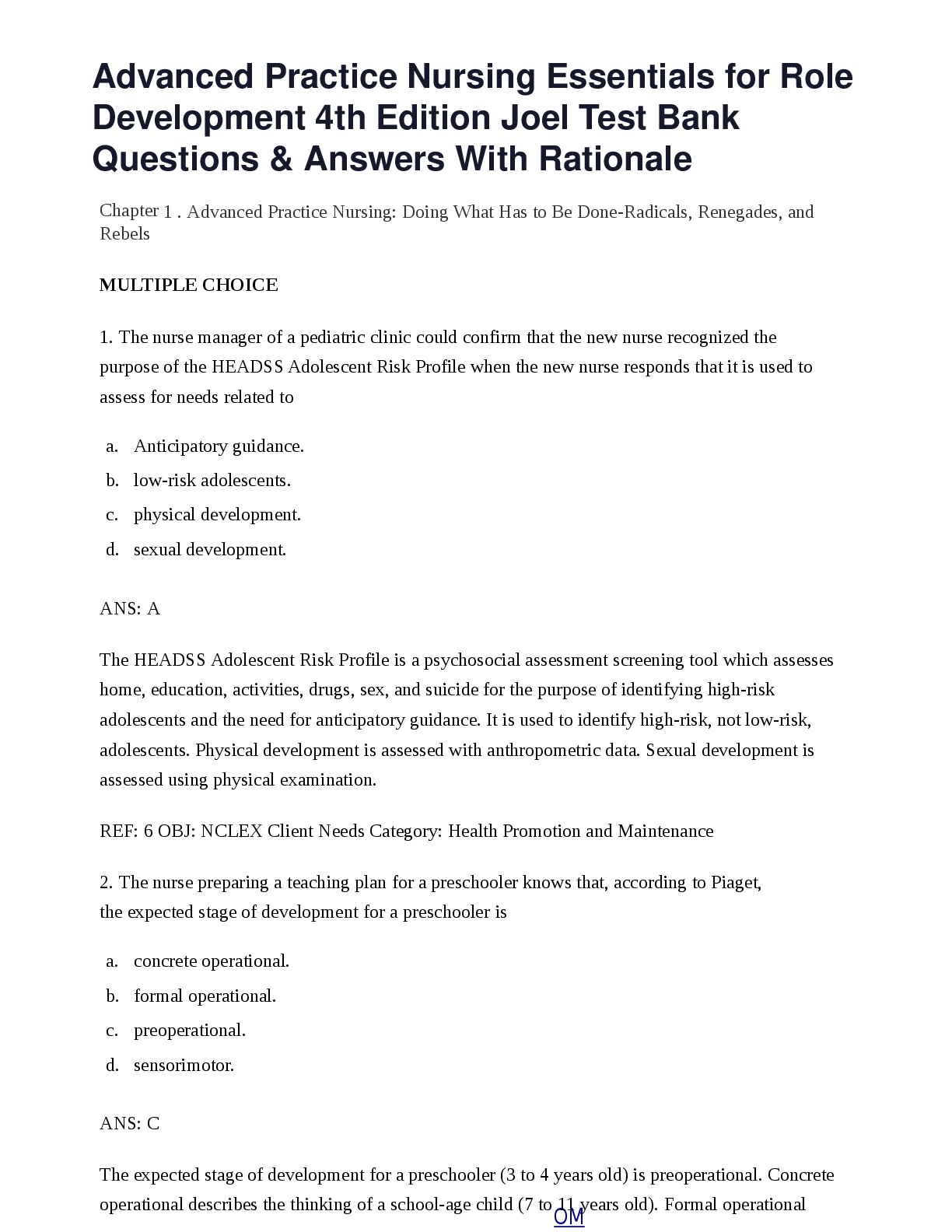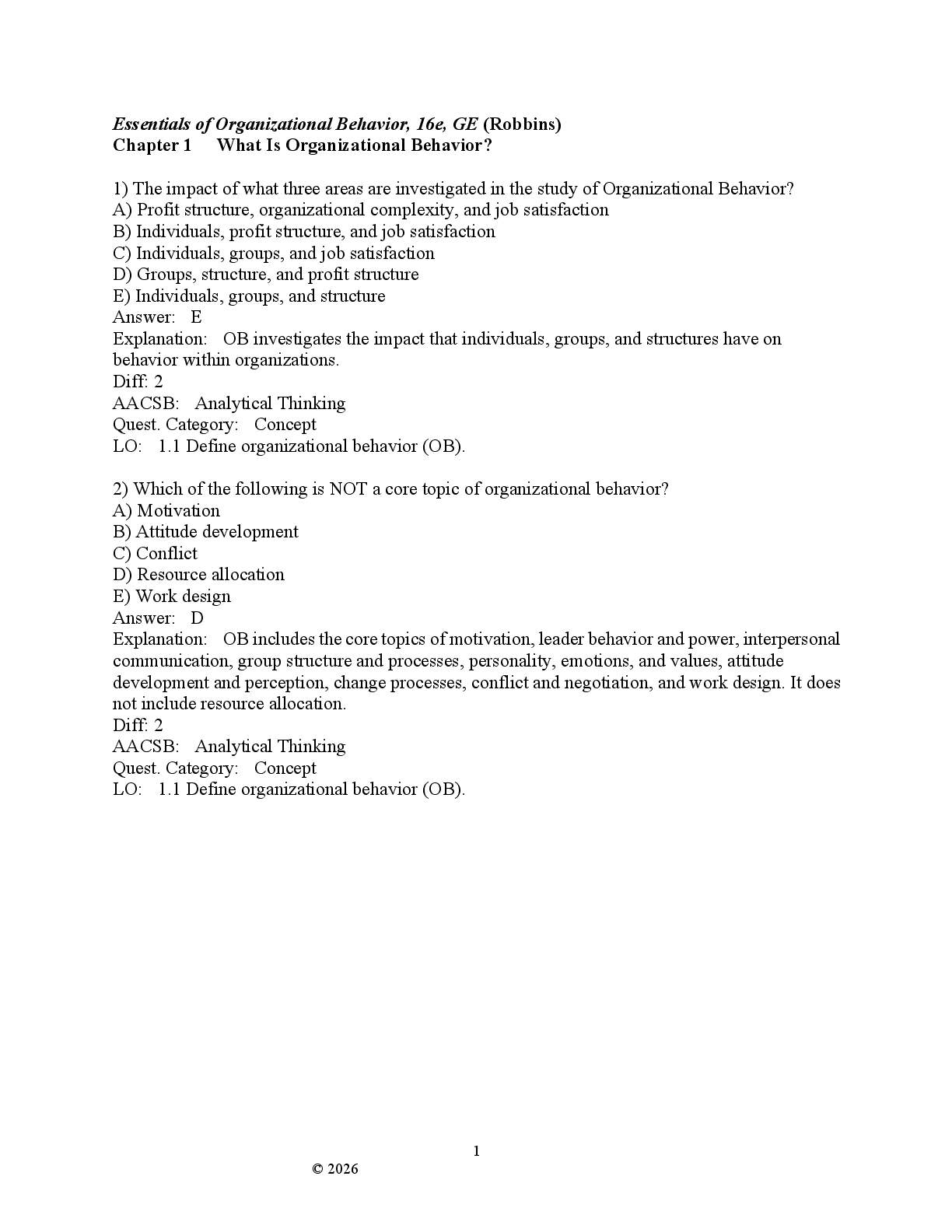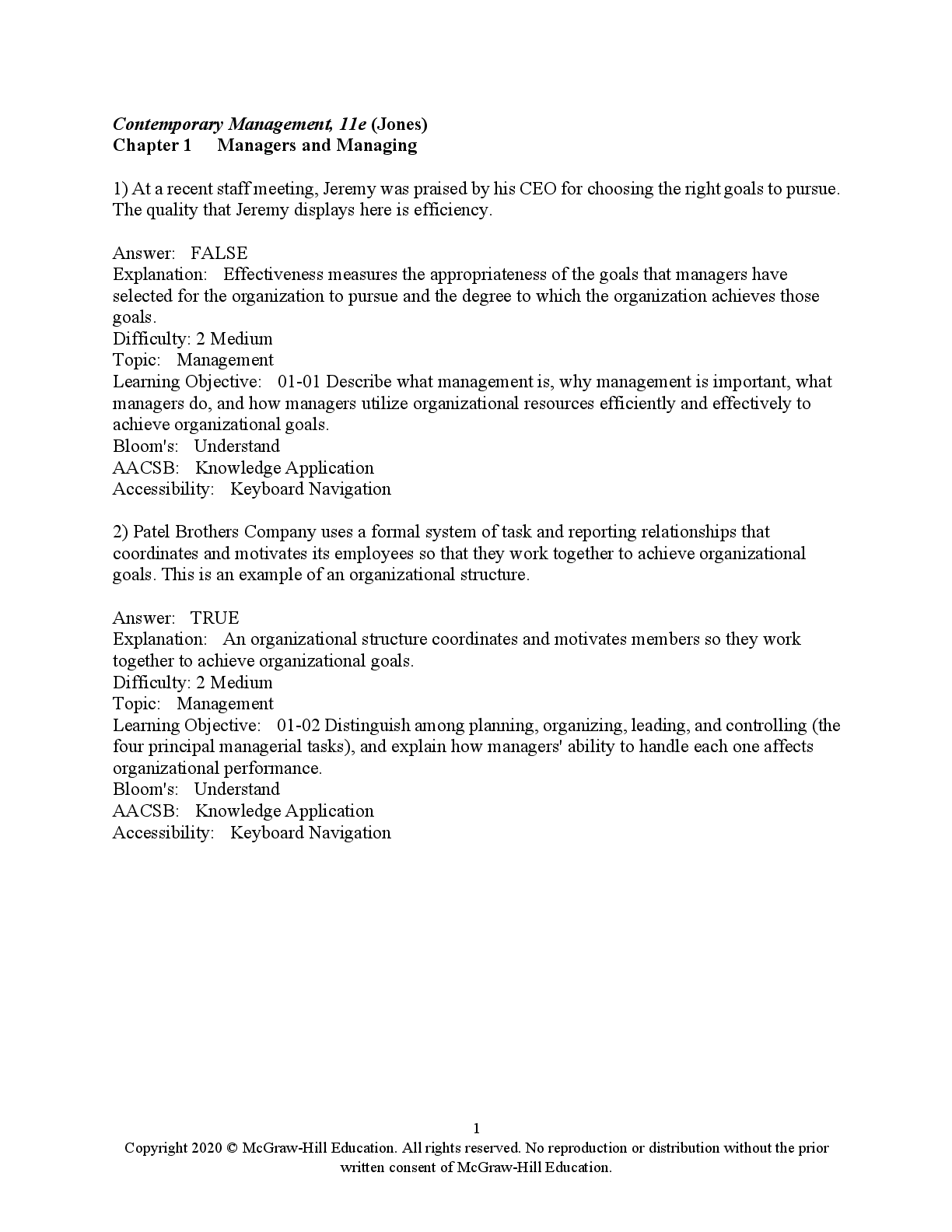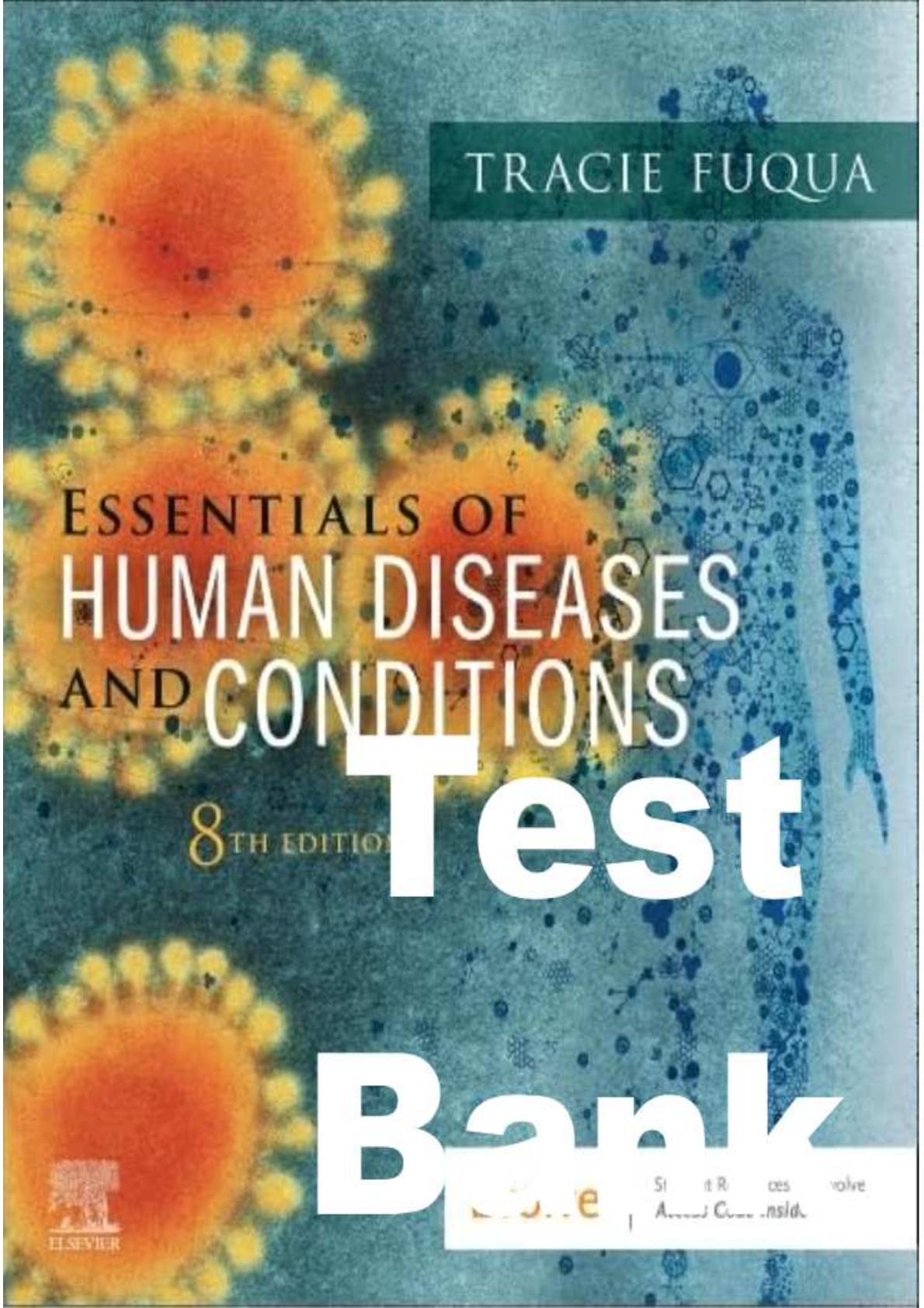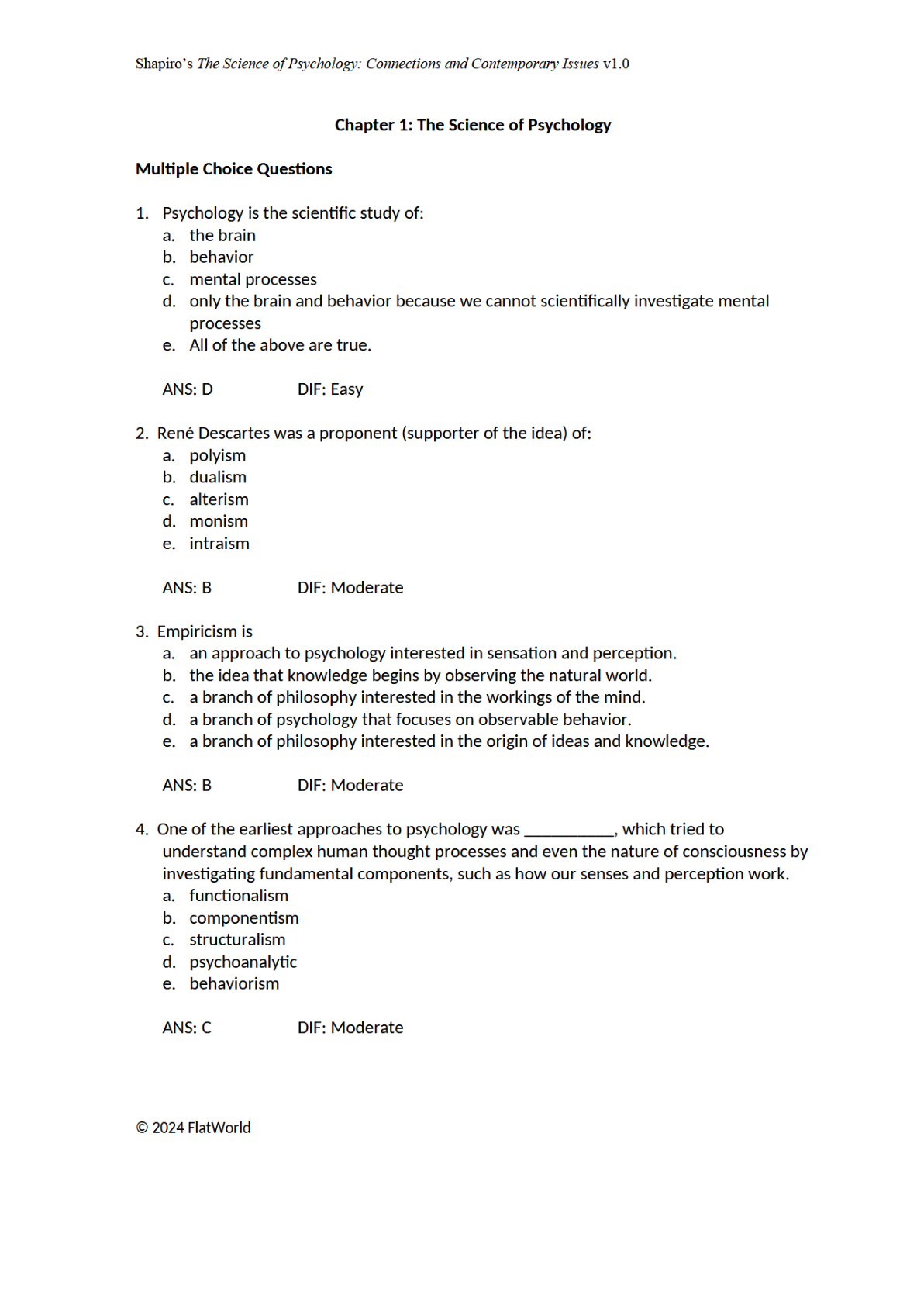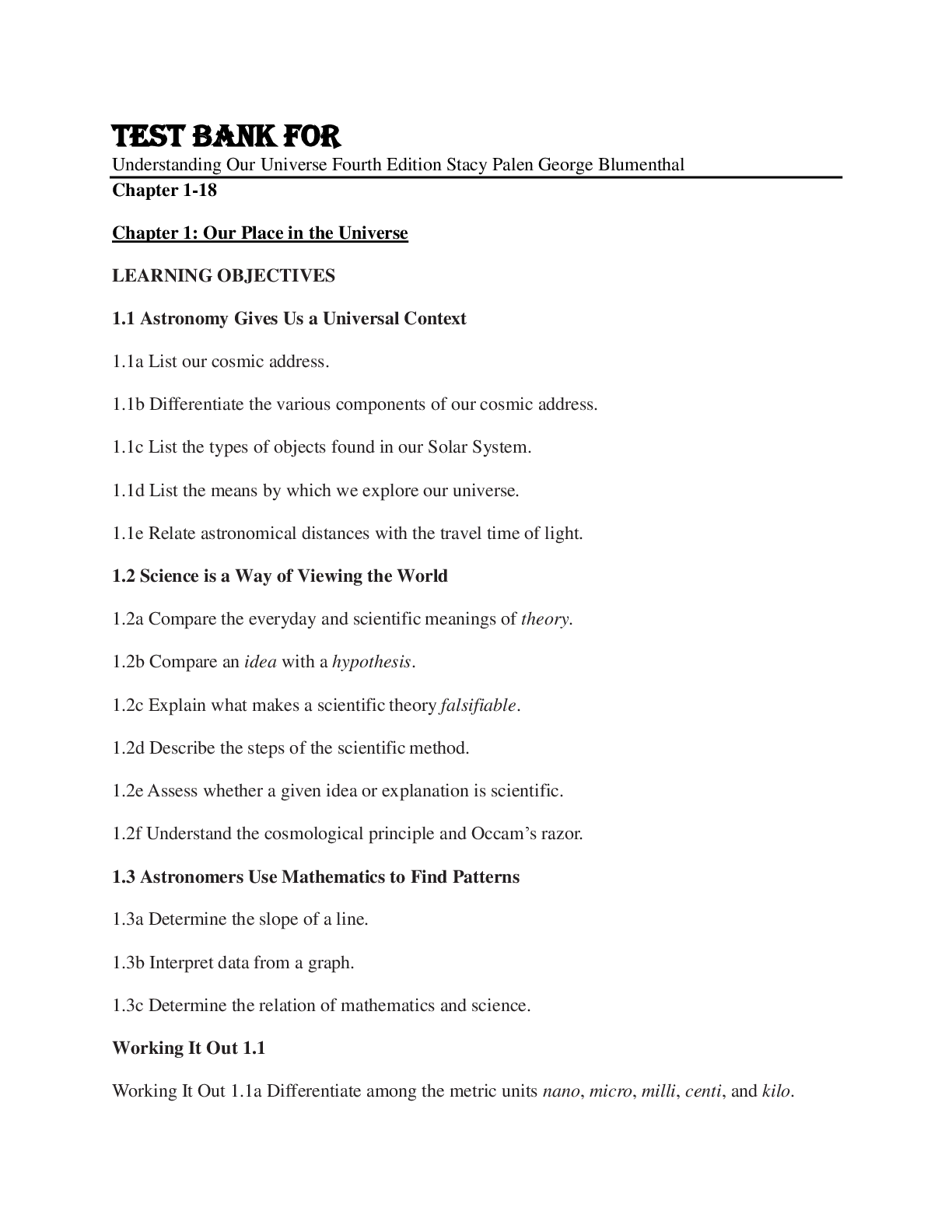Biology > TEST BANKS > PATHOPHYSIOLOGY 8TH EDITION MCCANCE TEST BANK, Complete Questions & Answers (2022/2023) (All)
PATHOPHYSIOLOGY 8TH EDITION MCCANCE TEST BANK, Complete Questions & Answers (2022/2023)
Document Content and Description Below
NURSINGTB.COM Hydrostatic pressure is the mechanical force of water pushing against cellular membranes. In the vascular system, hydrostatic pressure is the blood pressure generated in vessels by th ... e contraction of the heart. Blood reaching the capillary bed has a hydrostatic pressure of 25 to 30 mm Hg, which is sufficient force to push water across the thin capillary membranes into the interstitial space. The remaining options do not correctly identify the process described. PTS: 1 REF: Pages 29-30 23. Why is osmolality preferred over osmolarity as the measurement of osmotic activity in the clinical assessment of individuals? a. Plasma contains sodium and chloride, which influence the volume of solution. b. Volume affects perfusion more than the weight of solutes. c. More of the weight of plasma is influenced by solutes, such as protein and glucose, rather than by water. d. Osmotic activity depends on the concentration of solutes present in plasma, such as proteins and glucose. ANS: C In plasma, less of the plasma weight is water; therefore the overall concentration of particles is greater. The osmolality will be greater than the osmolarity because of the smaller proportion of water. Osmolality is thus the preferred measure of osmotic activity in clinical assessment of individuals. PTS: 1 REF: Page 30 24. A patient who has diarrhea receives a 3% saline solution intravenously to replace the sodium and chloride lost in the stool. What effect will this fluid replacement have on cells? a. Become hydrated c. Shrink b. Swell or burst d. Divide ANS: C A hypertonic solution has a concentration of greater than 285 to 294 mOsm/kg. An example of a hypertonic solution is 3% saline solution. Water can be pulled out of the cells by a hypertonic solution; therefore the cells shrink. The remaining options do not correctly describe the effect identified in the stem. PTS: 1 REF: Page 31 25. The transport of glucose from the blood to the cell is accomplished by which process? a. Active-mediated transport (active transport) b. Active diffusion c. Passive osmosis d. Passive-mediated transport (facilitated diffusion) ANS: D Facilitated diffusion is the means by which glucose is transported from the blood to the cells. The remaining options do not correctly identify this process. PTS: 1 REF: Pages 31-32 26. Potassium and sodium are transported across plasma membranes by: NURSINGTB.COM PATHOPHYSIOLOGY 8TH EDITION MCCANCE TEST BANK NURSINGTB.COM ANS: C During telophase, the final stage, a new nuclear membrane is formed around each group of 46 chromosomes, the spindle fibers disappear, and the chromosomes begin to uncoil. Cytokinesis causes the cytoplasm to divide into roughly equal parts during this phase. At the end of telophase, two identical diploid cells, called daughter cells, have been formed from the original cell. PTS: 1 REF: Page 37 34. Which statement is true about eukaryotic cells? a. They lack distinct nucleus. b. They contain compartments called organelles. c. They lack an encasing nuclear membrane. d. They are smaller than the typical prokaryote cell. ANS: B Eukaryotic cells have a characteristic set of membrane-bound intracellular compartments called organelles that include a well-defined nucleus and are larger than prokaryotes. The remaining statements are not true regarding eukaryotic cells. PTS: 1 REF: Page 2 35. Which statement is true about phagocytosis? a. Phagocytosis is an example of exocytosis. b. Phagocytosis is dependent on small vesicles. c. Phagocytosis involves the ingestion of bacteria. d. Phagocytosis focuses on solute molecules. ANS: C In phagocytosis, the large molecular substances are engulfed by the plasma membrane and enter the cell so that they can be isolated and destroyed by lysosomal enzymes. Two types of endocytosis are designated, based on the size of the vesicle formed. Pinocytosis (cell drinking) involves the ingestion of fluids and solute molecules through the formation of small vesicles, and phagocytosis (cell eating) involves the ingestion of large particles, such as bacteria, through formation of large vesicles (also called vacuoles). Phagocytosis in an example of endocytosis, not exocytosis. PTS: 1 REF: Pages 33-34 36. A muscle cell possesses which specialized function? a. Movement c. Secretion b. Conductivity d. Respiration ANS: A A cell has the potential to differentiation and to gain the ability to perform one of eight specialized functions. Muscle cells can generate forces that produce motion. Nerves cells are capable of conductivity. Cells of the adrenal gland, testis, and ovary can secrete. Respiration is a function that all cells possess. PTS: 1 REF: Page 2 NURSINGTB.COM PATHOPHYSIOLOGY 8TH EDITION MCCANCE TEST BANK NURSINGTB.COM 37. When a mucous gland cell creates a new substance from previously absorbed material, this process is known as which specialized cellular function? a. Excretion c. Reproduction b. Metabolic absorption d. Secretion ANS: D Certain cells, such as mucous gland cells, can synthesize new substances from substances they absorb and then secrete the new substances to serve elsewhere as needed. The other options are not used to describe the function described in the stem. PTS: 1 REF: Page 2 38. All cells are capable of what process? a. Excretion c. Metabolic absorption b. Movement d. Continuous division ANS: A All cells have the capacity to excrete, thus allowing them to rid themselves of waste products resulting from the metabolic breakdown of nutrients. The remaining options are not functions possessed by all cells. PTS: 1 REF: Page 2 MULTIPLE RESPONSE 39. What are the major chemical components of the cell membranes? (Select all that apply.) a. Lipids b. Sodium ions c. Carbohydrates d. DNA e. Proteins ANS: A, E The major chemical components of all cell membranes are lipids and proteins, but the percentage of each varies among different membranes. PTS: 1 REF: Page 12 40. Which cells lose their ability to replicate and divide? (Select all that apply.) a. Intestines b. Nerves c. Skin d. Lens of the eye e. Skeletal muscle ANS: B, D, E All types of cells undergo mitosis during the formation of the embryo, but many adult cells, such as nerve cells, lens cells of the eye, and muscle cells, lose their ability to replicate and divide. Intestines and skin cells retain their ability to replicate and divide. PTS: 1 REF: Page 37 NURSINGTB.COM PATHOPHYSIOLOGY 8TH EDITION MCCANCE TEST BANK NURSINGTB.COM 41. Which statements are true concerning the process of facilitated diffusion? (Select all that apply). a. Facilitated diffusion is also referred to as passive mediated transport. b. This process expends no metabolic energy. c. Moving solute molecules through cellular membranes are involved in this process. d. Movement up a concentration gradient is necessary. e. Facilitated diffusion is the primary means for water transport. ANS: A, B, C In passive mediated transport, also called facilitated diffusion, the protein transporter moves solute molecules through cellular membranes without expending metabolic energy. Downward movement along a concentration gradient is necessary. Osmosis is the movement of water down a concentration gradient. PTS: 1 REF: Pages 31-32 42. Passive transport is dependent on: (Select all that apply.) a. Semipermeable barrier membrane b. The process of osmosis c. Diffusion as a driving force d. A living host e. Hydrostatic pressure ANS: A, B, C, E Passive transport naturally occurs through any semipermeable barrier. It is driven by osmosis, hydrostatic pressure, and diffusion, all of which depend on the laws of physics and do not require life. PTS: 1 REF: Page 28 43. What is the primary function of proteins? (Select all that apply.) a. Proteins are binding units. b. Proteins are transport channels. c. Proteins are ribonucleoproteins. d. Proteins provide cell surface markers. e. Proteins are chemical reaction catalysts. ANS: A, B, D, E Protein functions include (a) recognition and binding units (receptors) for substances moving in and out of the cell; (b) pores or transport channels; (c) enzymes that drive active pumps; (d) cell surface markers, such as glycoproteins; (e) cell adhesion molecules; and (f) catalysts of chemical reactions. PTS: 1 REF: Page 15 MATCHING Match the structure with its function. Answers may be used more than once. ______ A. Endoplasmic reticulum ______ B. Ribosome ______ C. Secretory vesicle NURSINGTB.COM PATHOPHYSIOLOGY 8TH EDITION MCCANCE TEST BANK NURSINGTB.COM ______ D. Lysosomes 44. Packages and transports proteins. 45. Fuses with the plasma membrane to release contents from the cell. 46. Synthesizes and transports lipids. 47. Provides energy to digest proteins into amino acids. 44. ANS: A PTS: 1 REF: Pages 5-6 MSC: The endoplasmic reticulum (endo = within; plasma = cytoplasm; reticulum = network) is a membrane factory that specializes in the synthesis and transport of the protein and lipid components of most of the cell's organelles. 45. ANS: C PTS: 1 REF: Pages 6-7 MSC: Proteins from the endoplasmic reticulum are processed and packaged into small membrane-bound sacs or vesicles called secretory vesicles that collect at the end of the membranous folds of the Golgi bodies. The secretory vesicles then break off from the Golgi complex and migrate to a variety of intracellular and extracellular destinations, including the plasma membrane. The vesicles fuse with the plasma membrane, and their contents are released from the cell. 46. ANS: A PTS: 1 REF: Pages 5-6 MSC: The endoplasmic reticulum (endo = within; plasma = cytoplasm; reticulum = network) is a membrane factory that specializes in the synthesis and transport of the protein and lipid components of most of the cell's organelles. 47. ANS: D PTS: 1 REF: Page 7 MSC: Lysosomes function as the intracellular digestive system (see Figure 1-6). Lysosomal enzymes are capable of digesting most cellular constituents down to their basic forms, such as amino acids, fatty acids, and sugars. Match the structure with its function. Answers may be used more than once. ______ A. Passive-mediated transport ______ B. Active-mediated transport ______ C. Osmosis 48. Movement of water 49. Protein carrier 50. Facilitated diffusion 48. ANS: C PTS: 1 REF: Page 30 MSC: Osmosis is the movement of water down a concentration gradient; that is, across a semipermeable membrane from a region of higher water concentration to a lower water concentration. 49. ANS: B PTS: 1 REF: Page 32 MSC: In active-mediated transport, also called active transport, the protein transporter moves molecules against, or up, the concentration gradient. Unlike passive-mediated transport, active-mediated transport requires the expenditure of energy. 50. ANS: A PTS: 1 REF: Pages 31-32 MSC: In passive-mediated transport, also called facilitated diffusion, the protein transporter moves solute molecules through cellular membranes without expending metabolic energy. NURSINGTB.COM PATHOPHYSIOLOGY 8TH EDITION MCCANCE TEST BANK NURSINGTB.COM Chapter 2: Altered Cellular and Tissue Biology MULTIPLE CHOICE 1. Which type of cell adaptation occurs when normal columnar ciliated epithelial cells of the bronchial lining have been replaced by stratified squamous epithelial cells? a. Hyperplasia c. Dysplasia b. Metaplasia d. Anaplasia ANS: B Metaplasia is the reversible replacement of one mature cell by another, sometimes a less differentiated cell type. The best example of metaplasia is the replacement of normal columnar ciliated epithelial cells of the bronchial (airway) lining by stratified squamous epithelial cells. The other options do not accurately describe the event in the question. PTS: 1 REF: Page 54 2. The loss of the adenosine triphosphate (ATP) during ischemia causes cells to: a. Shrink because of the influx of calcium (Ca). b. Shrink because of the influx of potassium chloride (KCl). c. Swell because of the influx of sodium chloride (NaCl). d. Swell because of the influx of nitric oxide (NO). ANS: C A reduction in ATP levels causes the plasma membrane’s sodium-potassium (Na+ –K+ ) pump and sodium-calcium exchange to fail, which leads to an intracellular accumulation of sodium and calcium and diffusion of potassium out of the cell. (The Na + –K+ pump is discussed in Chapter 1.) Sodium and water can then freely enter the cell, and cellular swelling results. The other options do not accurately describe the result of ATP at the cellular level. PTS: 1 REF: Page 57 3. The mammary glands enlarge during pregnancy primarily as a consequence of hormonal: a. Atrophy c. Anaplasia b. Hyperplasia d. Dysplasia ANS: B Hormonal hyperplasia occurs chiefly in estrogen-dependent organs, such as the uterus and breast. The remaining options do not adequately describe the consequence of hormones on breast tissue during pregnancy. PTS: 1 REF: Page 53 4. Free radicals play a major role in the initiation and progression of which diseases? a. Cardiovascular diseases such as hypertension and ischemic heart disease b. Renal diseases such as acute tubular necrosis and glomerulonephritis c. Gastrointestinal diseases such as peptic ulcer disease and Crohn disease d. Muscular disease such as muscular dystrophy and fibromyalgia ANS: A NURSINGTB.COM PATHOPHYSIOLOGY 8TH EDITION MCCANCE TEST BANK NURSINGTB.COM Emerging data indicate that reactive oxygen species play major roles in the initiation and progression of cardiovascular alterations associated with hyperlipidemia, diabetes mellitus, hypertension, ischemic heart disease, and chronic heart failure. No current research connects the disorders mentioned in the other options to the effects of free radicals. PTS: 1 REF: Pages 59-60 5. Free radicals cause cell damage by: a. Stealing the cell’s oxygen to stabilize the electron, thus causing hypoxia b. Stimulating the release of lysosomal enzymes that digest the cell membranes c. Transferring one of its charged, stabilized atoms to the cell membrane, which causes lysis d. Giving up an electron, which causes injury to the chemical bonds of the cell membrane ANS: D A free radical is an electrically uncharged atom or group of atoms having an unpaired electron. Having one unpaired electron makes the molecule unstable; thus to stabilize, the molecule gives up an electron to another molecule or steals one. Therefore it is capable of forming injurious chemical bonds with proteins, lipids, or carbohydrates—key molecules in membranes and nucleic acids. The remaining options do not accurately describe the role played by free radicals in cell damage. PTS: 1 REF: Page 60 6. What is a consequence of plasma membrane damage to the mitochondria? a. Enzymatic digestion halts DNA synthesis. b. Influx of calcium ions halts ATP production. c. Edema from an influx in sodium causes a reduction in ATP production. d. Potassium shifts out of the mitochondria, which destroys the infrastructure. ANS: B The most serious consequence of plasma membrane damage is, as in hypoxic injury, to the mitochondria. An influx of calcium ions from the extracellular compartment activates multiple enzyme systems, resulting in cytoskeleton disruption, membrane damage, activation of inflammation, and eventually DNA degradation. Calcium ion accumulation in the mitochondria causes the mitochondria to swell, which is an occurrence that is associated with irreversible cellular injury. The injured mitochondria can no longer generate ATP, but they do continue to accumulate calcium ions. The remaining options do not accurately describe the consequence of plasma membrane dam [Show More]
Last updated: 2 years ago
Preview 1 out of 492 pages

Buy this document to get the full access instantly
Instant Download Access after purchase
Buy NowInstant download
We Accept:

Reviews( 0 )
$6.00
Can't find what you want? Try our AI powered Search
Document information
Connected school, study & course
About the document
Uploaded On
Jan 28, 2023
Number of pages
492
Written in
All
Additional information
This document has been written for:
Uploaded
Jan 28, 2023
Downloads
0
Views
214





